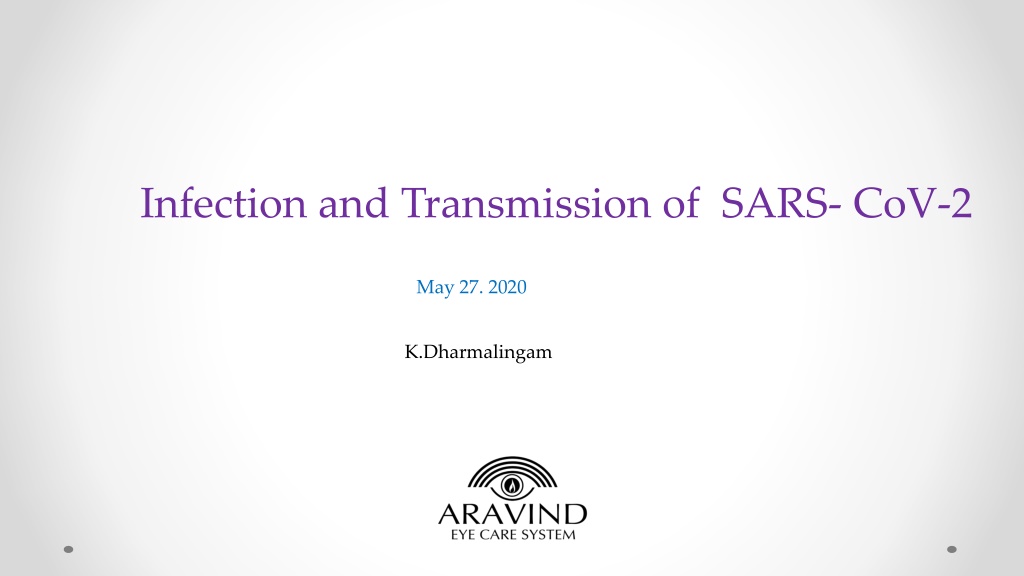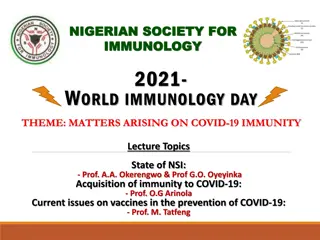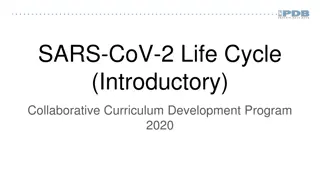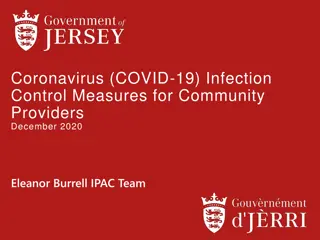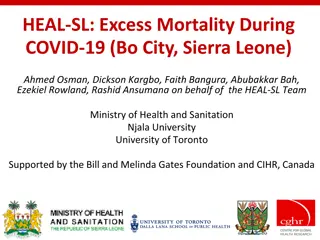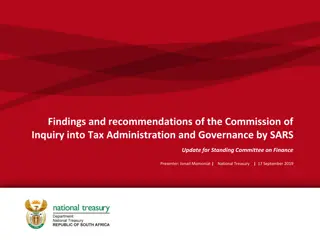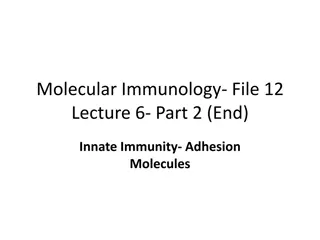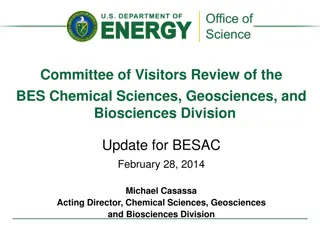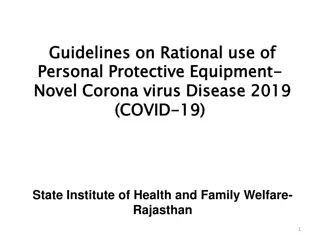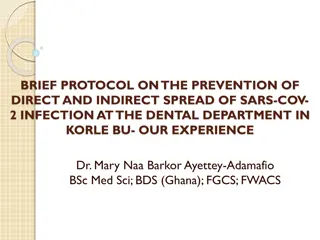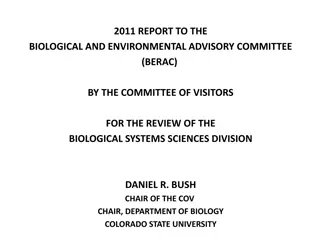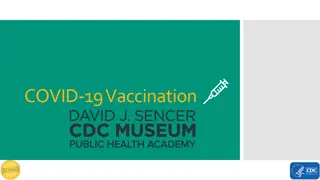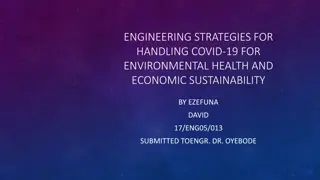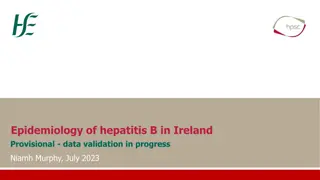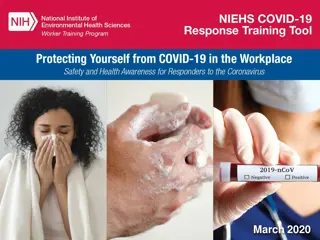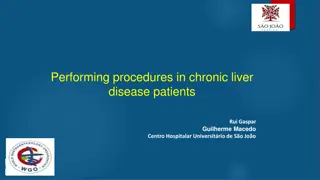Understanding Infection and Transmission of SARS-CoV-2
This content delves into the infection and transmission of SARS-CoV-2, discussing the possibility of spread from asymptomatic individuals, viral replication in the upper respiratory tract, viral RNA load, and distinct replication patterns in different tissues. Insights from studies and experts provide a comprehensive view of the dynamics of the virus.
Download Presentation

Please find below an Image/Link to download the presentation.
The content on the website is provided AS IS for your information and personal use only. It may not be sold, licensed, or shared on other websites without obtaining consent from the author. Download presentation by click this link. If you encounter any issues during the download, it is possible that the publisher has removed the file from their server.
E N D
Presentation Transcript
Infection and Transmission of SARS- CoV-2 May 27. 2020 K.Dharmalingam
Spread occurs from all these groups of patients Asymptomatic Likely but remote Prodromal Yes Oligosymptomatic Yes Polysymptomatic Yes
Spread from asymptomatic people Fauci, for one, still believes it does. "This evening I telephoned one of my colleagues in China who is a highly respected infectious diseases scientist and health official," he says. "He said that he is convinced that there is asymptomatic infection and that some asymptomatic people are transmitting infection." But even if they do, asymptomatic transmission likely plays a minor role in the epidemic overall, WHO says. Counterpoint Study claiming new coronavirus can be transmitted by people without symptoms was flawed By Kai Kupferschmidt Feb. 3, 2020 , 5:30 PM. Science.
Sites of active viral replication has direct relevance to the transmission
1 Active viral replication in upper respiratory tract and its implication for the containment of COVID-19 Nature Medicine. 2020, 26. 465
Viral RNA load in upper respiratory tract The average virus RNA load was 6.76 10 8copies per whole swab until day 5, The maximum load was 7.11 108 copies per swab. Swab samples taken after day 5 had an average viral load of 3.44 105 copies per swab
There were no discernible differences in viral loads or detection rates when comparing naso- and oropharyngeal swabs .
Independent replication in the throat is provided by sequence findings in one patient, who consistently showed a distinct virus in the throat as opposed to the lung. Two viral genotypes in the same patient. The disturbance of gustatory and olfactory senses points at an infection of the tissues of the upper respiratory tract. Together, these data indicate the active replication of SARS-CoV-2 in the throat during the first five days after the onset of symptoms. No (or only minimal) indications of replication in stool were obtained by the same method (Fig. 1g). See later for a current study
SARS-CoV-2 transmission is more efficient than SARS-CoV Active pharyngeal viral shedding at a time at which symptoms are still mild and typical of infections of the upper respiratory tract is unique to SARS-CoV-2 . Later in the disease, COVID-19 resembles SARS in terms of replication in the lower respiratory tract.
2. Is intestinal tract additional route of infection? 1.Development of gastrointestinal symptoms in some patients with COVID-19 . 2. Detection of viral RNA in faecal specimens in 53% of a cohort of 73 patients 3. Demonstration of of active SARS-CoV-2 replication in human enteroids, an in vitro model of human intestinal epithelium 4. Isolation of infectious virus from a patient with diarrheal COVID-19 Currently, the route(s) leading to enteric infection remains unclear. 1. Intestinal epithelial cells are primarily infected with SARS-CoV-2 via the oral fecal route or 2. Whether enteric infection is secondary to respiratory infection. Nature Medicine May 13.
Direct and indirect transmission of SARS -CoV-2 1.Droplet/aerosol 2. Fecal 3. Surface transmission. (INDIRECT)
Stability of SARS CoV2 in aerosol and surfaces Measurement done using the titre of virus Tissue-culture Infectious Dose [TCID50] per milliliter) SARS-CoV-2. Viral strain used nCoV-WA1-2020 (MN985325.1) N Engl J Med April 16, 2020
Orange SARS CoV-2 Blue SARS CoV-1
Airborne or Droplet Precautions for COVID-19 Journal of Infectious Diseases 2020
Droplet. Vs Aerosol The WHO uses a cutoff limit of 5 m to differentiate between aerosols ( 5 m) and droplet (>5 m) [38] transmission routes. In addition, the size of a droplet is dynamic and changes within seconds during the transit from the respiratory tract to the environment due to evaporation. Ambient condition is critical. Eight of the 10 studies discussed a horizontal trajectory greater than 2 meters ( 6 feet) for a range of droplet sizes of less than 60 m
Aerosol transmission of previous SARS. virus Earlier SARS (not CoV-2) was classified as predominantly transmitted through contact and droplet modes, but aerosolized transmission well beyond 2 meters ( 6 feet) was reported in the Amoy Gardens outbreak [32].
Aerosol transmission possible but no data on live viral load available This further supports the conclusion that transmission cannot be neatly separated into droplet versus airborne routes, and that it is likely driven by both airborne, and large droplets, carried by the respiratory gas cloud. In light of the lack of definitive transmission data for SARS-CoV-2, as well as persistence of the virus in the air 3 hours after aerosolization in laboratory settings [33], the precautionary principle in the initial CDC guidance was justified
Emerging Infectious Diseases. Volume 26, Number 7July 2020 https://doi.org/10.3201/eid2607.200885 1. SARS-CoV-2 was widely distributed in the air and on object surfaces in both the ICU and GW, implying a potentially high infection risk for medical staff and other close contacts. 2. The environmental contamination was greater in the ICU than in the GW; thus, stricter protective measures should be taken by medical staff working in the ICU. 3. The SARS-CoV-2 aerosol distribution characteristics in the GW indicate that the transmission distance of SARS-CoV-2 might be 4 m.
Emerging Infectious Diseases. Volume 26, Number 7July 2020 https://doi.org/10.3201/eid2607.200885 Our study has 2 limitations. 1. The results of the nucleic acid test do not indicate the amount of viable virus. 2. For the unknown minimal infectious dose, the aerosol transmission distance cannot be strictly determined. Overall, we found that the air and object surfaces in COVID-19 wards were widely contaminated by SARS-CoV-2. These findings can be used to improve safety practices.
Our results indicate that aerosol and fomite transmission of SARS- CoV-2 is plausible, since the virus can remain viable and infectious in aerosols for hours and on surfaces up to days (depending on the inoculum shed). Our initial results suggest that measures to contain viral spread should aim at droplet, rather than fomite, based transmission.
Interaction substitution to prevent the spread of COVID-19. Societies over the next few months will face the choice between continued lockdown with huge economic and social costs for everyone, versus lifting restrictions and replacing them with effective public-health interventions, including advice on social distancing, hygiene, protection of high-risk groups and widespread testing. Nature Medicine | www.nature.com/naturemedicine
Aerosol transmission of SARS- CoV-2is real. Six feet social distancing may be in adequate, if we encounter asymptomatic silent shedders . Increasing evidence for SARS-CoV-2 suggests the 6 ft WHO recommendation is likely not enough under many indoor conditions where aerosols can remain airborne for hours, accumulate over time, and follow air flows over distances further than 6 ft Reducing transmission of SARS-CoV-2. Science. 27 ,May. 2020. K.Dharmalingam 29 May
79% of transmission is through the silent transmitters Evidence suggests that SARS-CoV-2 is silently spreading in aerosols exhaled by highly contagious infected individuals with no symptoms. Owing to their smaller size, aerosols may lead to higher severity of COVID-19 because virus-containing aerosols penetrate more deeply into the lungs.
Viral Load in the Aerosol Produced by the Speaker. Estimates using an average sputum viral load for SARS- CoV-2 indicate that 1 min of loud speaking could generate >1000 virion-containing aerosols. Assuming viral titers for infected super-emitters (with 100-fold higher viral load than average) yields an increase to more than 100,000 virions in emitted droplets per minute of speaking.
It is essential that control measures be introduced to reduce aerosol transmission.
Ref. Reducing transmission of SARS-CoV-2 Kimberly A. Prather1, Chia C. Wang,2,3 Robert T. Schooley4 1Scripps Institution of Oceanography, University of California San Diego, La Jolla, CA 92037, USA. 2Department of Chemistry, National Sun Yat-sen University, Kaohsiung, Taiwan 804, Republic of China. 3Aerosol Science Research Center, National Sun Yat-Sen University, Kaohsiung, Taiwan 804, Republic of China. 4Department of Medicine, Division of Infectious Diseases and Global Public Health, School of Medicine, University of California San Diego, La Jolla, CA 92093, USA. Email: kprather@ucsd.edu Masks and testing are necessary to combat asymptomatic spread in aerosols and droplets
